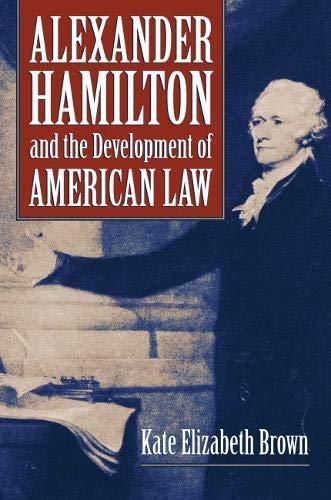Book review: ‘Alexander Hamilton and the Development of American Law’
Published 12:00 am Sunday, January 13, 2019

- BOOK REVIEW
“Alexander Hamilton and the Development of American Law” by Kate Elizabeth Brown. Lawrence: University Press of Kansas, 2017. 308 pages, $34.95 (hardcover).
The incredible success of the hip-hop musical “Hamilton” has returned this founding father to general name recognition in this country and likely saved his image on the $10 bill as well. Alexander Hamilton’s service as the first secretary of the treasury under George Washington is generally credited with putting the fledgling United States on a solid foundation financially, and his death in a duel in 1804 with Vice President Aaron Burr is also well known. However, Hamilton’s influence on the development of American law has not been well documented until the publication of this excellent volume by Kate Elizabeth Brown.
Trending
Brown, a new faculty member in Western Kentucky University’s History Department, opens her introduction with this statement: “Alexander Hamilton never handed down decisions from a Supreme Court bench, nor did he write influential treatises on law. Yet he became the central figure in the development of American law during the early republic era.” Although it may seem strange to readers that he and other founding fathers looked to English law for guidance in establishing American jurisprudence in the first few decades after separation from English rule, Brown says that they adapted principles of English law and “applied them forward to shape a distinct and novel American republic.”
The author believes Hamilton’s most profound influence on the development of American law is his adaptation of concurrence, which “provides harmonizing rules so that the federal and state governments can simultaneously exercise the same powers, like taxing, borrowing or adjudicating contract disputes.” Brown cites Hamilton’s work in Federalist Nos. 32 and 82 as providing guidelines for the extent and limits of legislative and judicial concurrence. She also says that his influence on American law stemmed from his law practice and his role as “drafter, ratifier, expositor, and … administrator of the new constitutional order.”
In chapter one on “Creating the Federal Magistracy,” one of the early legal cases discussed concerned a customs inspector in New York who had innocently violated the 1790 Collection Act by landing cargo, in this case, seven or eight hogsheads of molasses, after sunset. After a grand jury indicted him while also acknowledging that he had acted without fraudulent intent, he appealed to his boss, the treasury secretary, in hope that he could use his pardoning power under the Remitting Act.
Hamilton was skeptical but checked first with the district attorney, who said the act was intended to remit penalties for merchants and ship captains and not for treasury employees. Hamilton suggested asking for a presidential pardon, but even this option raised a constitutional question because half of the fine levied was intended to reward the informer who had reported the violation and dropping it would violate that individual’s rights. Hamilton and Washington were both very careful to be sure that a pardon conformed to existing law and it was made conditional upon payment of the informant fee. Brown points out that Hamilton’s regard for individual rights in this case echoed Federalist No. 78 and also presaged Chief Justice John Marshall’s similar conclusion in Marbury v. Madison.
When Pennsylvania distillers refused to pay an excise tax on their product in the event generally known as the Whiskey Rebellion, Hamilton issued his “Report on the Difficulties in the Execution of the Act Laying Duties on Distilled Spirits,” in which he defended his collectors’ right to search and explained that the problem stemmed from the fact that many distillers did not separate their place of business from their home and that this was necessary to avoid the charge of unreasonable search and seizure.
The incident also provided Washington with the opportunity to exercise his pardoning power for the convicted rebels. The author comments on what made Hamilton’s five years as treasury secretary so extraordinary: “Without precedent to guide him, Hamilton was forced to ‘trace out his own path’ in order to figure out how to interpret and execute statutory law within the untried bounds of the new Constitution. As a department head, Hamilton learned to improvise daily, and he relied heavily on the executive’s inherent discretionary authority to allow him the freedom to maneuver, reason and adapt accordingly.”
Trending
Chapter three is titled “Creating the ‘Commercial Republic’: Neutrality and Law in the American Courts.” The author maintains that the Washington administration’s decision in 1793 to declare neutrality during the French Revolutionary Wars, followed by subsequent administrations’ maintaining this policy for almost two decades, “was the most important event to influence the development of American commercial law in the early republic. Neutrality amid a world at war … had tremendous implications for the American economy, resulting in a flourishing trade into lucrative overseas markets, the growth of an American marine insurance market, and general prosperity at home.”
Although Hamilton’s efforts were crucial to establishing an American commercial republic, his support for an American alliance with England rather than France and for the Jay Treaty helped create an opposition party to the Federalist agenda that prefigured the two-party division that would follow. Hamilton was even pelted with stones by angry opponents in his own New York City. After surveying state and federal cases involving foreign decrees, Brown believes “neutrality created concurrence between the state and federal courts.”
In the following chapter, “Developing the Jurisprudence of Federalism: Hamilton’s defense of Federal Fiscal Powers,” the author opens with the financial panic of 1791 when Boston taxed its residents’ personal property and asked the treasury secretary for access to the names and valuation of U.S. bondholders so they could be included in the levy. Hamilton denied the request, citing the harmful effects of such taxation on the public credit. Hamilton cited no legal or constitutional arguments but realized fully that such a tax seriously threatened the success of his fiscal program and the newly nationalized war debt.
Brown contrasts Hamilton’s response with Marshall’s bold ruling in 1829 in a very similar case in Weston v. Charleston. Marshall said Charleston’s attempt to tax federal bonds was unequivocally unconstitutional, according to Brown, because “the state had no authority to infringe on the national government’s sovereign, and supreme, authority to borrow money, nor to interfere with the terms of its contracts.” The author says Hamilton was the pivotal figure in the development of this fiscal jurisprudence that later allowed Marshall to mount such a defense.
Hamilton’s principle of broad construction of federal powers listed or implied in Article I, section 8 of the Constitution first appeared in his 1791 argument in favor of establishing a national bank. Five years later, this interpretation was crucial in the case of Hylton v. U.S., which involved Hamilton’s only oral argument before the U.S. Supreme Court and the first time the court reviewed the constitutionality of a federal law. This was a “staged case” to force the court to consider Virginia’s challenge to the federal taxing power, in this case on carriages. The Supreme Court justices sided with the federal government. Hamilton also used broad construction to hold that federal securities were contracts and that this conferred tax immunity on them. Here he was protecting these investments not only from state taxes, but from federal as well.
Chapter five deals with “securing foreign capital with the law of the land,” and the author discusses Hamilton’s 1791 “Report on Manufactures” and its argument to Congress that foreign investment not only helped refinance American war debts, but also strengthened American commerce. Contrary to general assumptions, Hamilton attracted foreign investment by also relying on state courts, statutes and inherited law to accomplish national aims as well as federal laws and institutions. Because New York common law forbade aliens from legally owning land outright, Hamilton as attorney had to be creative and use a combination of trusts and other equitable interests to secure foreign investments by a group of Dutch financiers known as the Holland Land Company. Brown credits Hamilton with helping transform the law of mortgages in New York as well as developing the rights of both debtors and creditors in American law.
In chapter six, ”Litigation, Liberty, and the Law: Hamilton’s Common Law Rights Strategy,” the author tackles a subject not normally connected to Hamilton, his defense of civil and political rights. Brown says the key to understanding his rights strategy is his distinction between a “strict” and an “extensive” interpretation of common law. The British occupation of New York City during the Revolutionary War exacerbated the relationship between Patriots and Loyalists and British subjects living in New York after the war ended. New York’s legislature had passed Trespass, Citation and Confiscation Acts that unfairly targeted Loyalists as a group and led to extensive biased litigation against them.
Hamilton defended Loyalists in numerous cases because he believed their treatment lacked due process and was therefore unjust. According to the author: “Hamilton considered the entire English common law tradition to be intimately and integrally tied to American jurisprudence as a source of precedent, process, and substance for republican law.” Hamilton successfully campaigned in the state assembly for a modified Trespass Act and his broad interpretation of common law clearly influenced New York’s statutory bill of rights, passed in 1787.
In a different rights case, People v. Croswell, a criminal libel prosecution in 1803, Hamilton used his extensive interpretation of common law to argue for a retrial and broader understanding of libel law. The chief justice presiding over the trial had instructed the jury to consider only the fact of publication and whether the wording used meant what the prosecution claimed. The truth of the allegations about President Thomas Jefferson was not permitted to be a factor. Although the motion for retrial failed on a tie vote, Hamilton’s broader interpretation of common law would soon define and change libel law as well. Chancellor James Kent later commented on Hamilton’s eloquent argument in the Crosswell case: “His whole soul was enlisted in the cause, and in contending for the rights of the jury and a free press he considered that he was establishing the finest refuge against oppression.”
Brown includes extensive notes on the many legal cases considered, a bibliography and an index. Her excellent book provides valuable insight into how the federal government developed and functioned under Washington and his immediate successors. She demonstrates very clearly that “Hamilton’s legal influence thus reaches far into the development of the jurisprudence of American federalism, and it therefore becomes part of the formative core of American constitutionalism itself.”
I recommend this book very highly for anyone interested in the founders of the early American republic or in legal history.
– Reviewed by Richard Weigel, WKU History Department.






